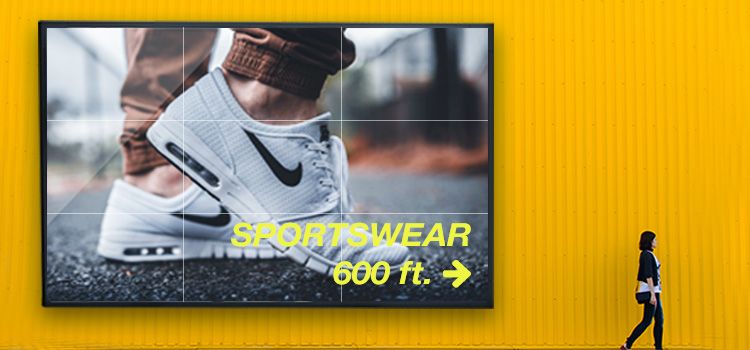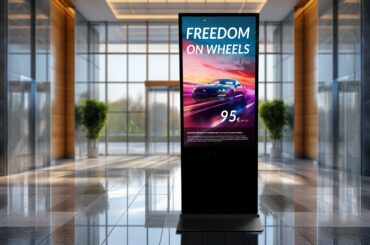Finding the right advertising screen among all the different options available isn’t easy. Ideally, you know all of your requirements before you begin your project, so there are no mistakes along the way. But we all know that this is sometimes not the case.
But before you give up, this post will help walk you through some of your options and help choose the features which are the most important to get your project off the ground. So, let’s jump in!
- Start by asking the right questions
- Consider the environment of your digital display
- Find the right display size
- Resolution – Full HD, HDMI, and 4K, what does that even mean?
- Software compatibility
- Compare more than just brands
- Commercial vs. Consumer Grade
#1 Start by asking the right questions
Every project is different, but that doesn’t mean that there aren’t some central questions which apply to almost everyone:
- What are you trying to accomplish by installing a commercial display?
- Are you focusing on information, entertainment, advertising, or mixed content?
- What will be the purpose of my screen?
- What kind of content do I want to display?
- Is your content going to be dynamic? Or on fixed images or text?
These types of questions should be kept in the back of your mind and asked through the planning stages of your project. As the project progresses, the answers may change over time as other factors, such as budget and timeline, become better defined. Additionally, the most specific your answers, the more likely you will be able to narrow your focus around the price, size, and specifications of the digital signage display that you need.
#2 Consider the environment of your digital display
There are very few limits on where you can place a digital screen. Depending on your project, placing a digital display outside might be a good way to attract visitors and get attention. However, you should keep in mind that there are additional considerations that can impact the performance of your outdoor digital signage. If you’re headed that way, I suggest you check out our recent blog post on the future of digital technology that outlines some of the biggest factors to consider.
Even if you are doing a more traditional indoor digital display there are some environmental factors to be aware of:
- Panel Brightness – Whether you choose an LED or LCD display, it should have enough power to be able to adapt to various lighting conditions. The area where the two differ from each other is in the form of backlighting. Not sure which direction to go, then head over to our blog post which breaks everything down for you.
Waste – It is estimated that in 2017 paper and paperboard accounted for 67 million tons of waste or approximately 25% of all waste in the United States, according to the Environmental Protection Agency. Shifting from paper to digital is a great benefit that you should use to your advantage when trying to sell stakeholders on your digital displays.
#3 Find the right display size
This is one that sounds the easiest to answer. You have some old TVs that you aren’t using, so mount them on a wall and presto, a digital display. Does it really matter how big the TV is as long as people can see it?
There are two key factors to keep in mind: the size of the area your screen is located in and how far you expect people to be located from your TV. The bigger the space you are placing your display, the more engaging and emotional your effects should be to get the attention of the viewer. If you have a really large space, you might want to consider using a video wall. One of our newest Plugins, Screen Sync, makes this process even easier than before.
Bigger video walls (starting at 45” inches) are best used in places like trade shows, in-store windows, conferences, and classrooms. Whereas, a smaller advertising screen is ideal for store shelves, checkout areas, or smaller spaces like pharmacies or hair salons.
Depending on what your LCD screen or LED screen will be used for (advertisements, information or entertainment) and what your content will be (videos or images), it also can influence screen size.

#4 Resolution – Full HD, HDMI, and 4K, what does that even mean?
So, we’ve discovered that size does matter, but another important factor that can get overlooked is the resolution. It’s important to remember that not every monitor which is advertised as HD actually meets the new HD requirements.
For example, an LED screen can be promoted as a new version of HD. But that doesn’t mean that the LED display provides all of the features of an advertised HD (or supported HDMI) version. As if it couldn’t get even more confusing, not every screen that supports HD means that it is the right HD screen for your project. For example, a resolution of 720p, or 1024×768 pixel, is great for a regular TV broadcast, but it might not be the optimal choice for your digital signage project.
The way that you connect your digital signage player with a display is through an HDMI cable. We won’t get into the nitty-gritty of HDMI here, but if you want to head down that rabbit hole, there’s a blog post for that.
If you are looking for FullHD support, then the standard resolution is 1080p. However, new versions already support the possibility of a resolution that is 4 times of FullHD, hence how the term 4K came to be. Which is a great trivia fact, that you can share at your next party.
#5 Software compatibility
So, you found the right screen, added a digital signage player and then find out that all of the different components don’t work with each other. The problem is probably the software that you are trying to use.
How should you go about choosing the right digital signage software? Well, I wouldn’t be doing my job if I didn’t recommend that you look at viewneo as a solution. Our cloud-based software is designed to work together with our hardware line to provide a seamless user experience.
Not sold, yet? No problem, there are lots of digital signage software solutions out there and it is critical that you find the one that will best fit your needs. Capterra is a company that lists a wide variety of digital signage companies with product information, as well as reviews to allow you to compare products.

#6 Compare more than just brands
Of course, all manufacturers advertise their systems as being the best product out there. Well-known brands are often seen as an indicator of a “good product” in itself. But even if you prefer a certain brand, you should keep one thing in mind:
It doesn’t depend on the brand but on the hardware. Oftentimes different manufacturers offer identical hardware under a variety of different brands. What is more important is how the hardware has been designed to interact with the digital signage software.
So, remember: Always compare individual models and their specifications, not just the brands.
#7 Commercial vs. Consumer Grade?
What is the advantage, if any of a commercial-grade LED or LCD display?
- Wider brightness settings range
- Longer operation time
- Longer product lifespan
- Anti-glare protection for screens
- Built-in sensors to accommodate light changes
Whether these are important features for you is going to depend on the nature of your project and the answers to the questions discussed in the first point. Additionally, it is important to consider the price point differences between commercial-grade products. If you are looking to get a project off the ground quickly, most times a consumer grade product will be able to meet most of your specifications.
How to use your digital advertising screen the right way
So, you are finally ready to make your selection. Now it’s important to get the most out of your TV installation, which leads us back to #1 on our list, closing the loop: What’s the purpose of your digital signage installation?
Whatever you want to achieve by using your digital signage advertising screens, the best place to start most efficiently is a well thought out content strategy! Because no advertisement works better than one that provides its viewers with truly relevant messaging. So fill your LED display or your LCD screen with images and text that will be engaging and memorable.
If you have any questions or want some assistance with setting up your digital signage project, please reach out to us. We love to help! And don’t forget that you can sign up for a free 30 day trial of viewneo at any time to try it out for yourself.





